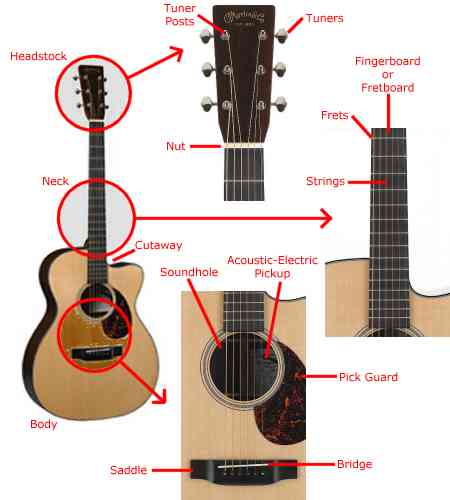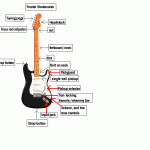I just got the guitar…now what? (part 2)
Oct 27, 2009 Music Theory
Okay, so now we know what are all the parts of the guitar. Let’s look at the stuff that we will be using most – the strings, tuning pegs and the frets.
Tuning
First of all, the purpose ot the tuning pegs is to tighten or loosen the tension on the string, thereby raising and lowering the pitch of the string respectively. The strings can be tuned to any number of pitches, the standard tuning is as follows:
E – 6 -fattest string (“top” of neck)
A – 5
D – 4
G – 3
B – 2
e – 1 – thinnest string (“bottom of neck”)
I use a simple mnemonic: “Every Astronaut Does Good But Elmer”. Most people will use an electronic tuner or pitch pipe entire guitar or a tuning fork to tune a single string and then tune the rest of the strings to that reference. How does that work?
Nearly every electronic tuner has the ability to listen to the sound a string makes and tell you what the closest note is to that sound. It generally will give some sort of visual representation to the player of whether they are in tune, sharp(#) or flat (b). Tightening the string will make it closer to in tune when the tuner displays that the note is flat, conversely loosening the string will make it closer to in tune when the tuner displays that the note is sharp. Remeber to ensure you are trying to tune to the correct note for the assigned string.
A pitch pipe generally has six tubes that you can blow in to and get a reference tone to which you can tune. This helps build your ear for hearing the dissodence between notes that are not in tune with each other but can be quite a challenge for the beginner.
A tunning fork is a device that produces a single tone when struck. There are designed to play one note that can be used as a reference tone. Most guitarists that use tuning forks use forks that are tuned to “A=440hz”. That means that the fork will vibrate 440 times a second producing the perfect A note. When properly tuned your guitar’s A string (5th string) will vibrate at exactly 440 times a second. Once that string is tuned, the guitarist can tune the remaining strings in reference to that string (more on that later).
Or you could just use this one from Guitar For Beginners.com :
Now back to the stuff I mentioned earlier, tuning forks. A tuning fork is manufactured to produce a specific tone. That is their sole purpose.
Nice explanation on YouTube.
Tuning your guitar is a matter of simply tightening or loosening the string using the tuning pegs. By turning your tuning peg so that the string is further wrapped around the peg is tightening the string and thereby making the pitch (or sound the string creates) “higher”. Conversely, turning the tuning peg so that string is actually relieved off of the peg is loosening the string and causes the pitch to be “lower”.
Tags: beginnings, guitar, parts, theory
I just got the guitar…now what? (part 1)
Oct 22, 2009 Music Theory
Congrats…condolences…you just got a guitar!!!
Guitars are without a doubt the coolest and sweetest instruments ever created by man!!! Take the piano for instance, there is only one place on the piano that you can play the E note an octave and a half higher than middle C. One place? On the guitar, you can play that note in 5 different places on 5 different strings. Because of the way the guitar is tuned (in fourths – explanation coming soon), there is an amazing number of ways to approach chord construction.
So the guitar is the first instrument you’ve ever had and you thought when you saw it in the store or under the Christmas tree that I can learn a couple of chords and it’s off to the beach and and a campfire. Well, yeah, that works if you want to play “Louie, Louie” for a 5 hour period. So what do you do the next day? Truck on down to the Guitar Center and pick up the simplest Mel Bay guitar instruction book. You get it home and start your journey into “Van Halen”-esque stardom. Just make sure you master “Aura Lee” first.
Or…you could pick up a few basic theory rules and start way ahead of the crowd. Probably the reason why you ended up here, so let’s look at some basic stuff.
First, let’s start by discussing some common terms for parts of the guitar. Speaking the same language will be very important and a recurring theme in this series. Let’s take a look at some parts.
 |
 |
Click on the image to see a bigger version.
Ok, that should cover the basics.
Next up, making sound!!!
Tags: beginnings, guitar, parts, theory